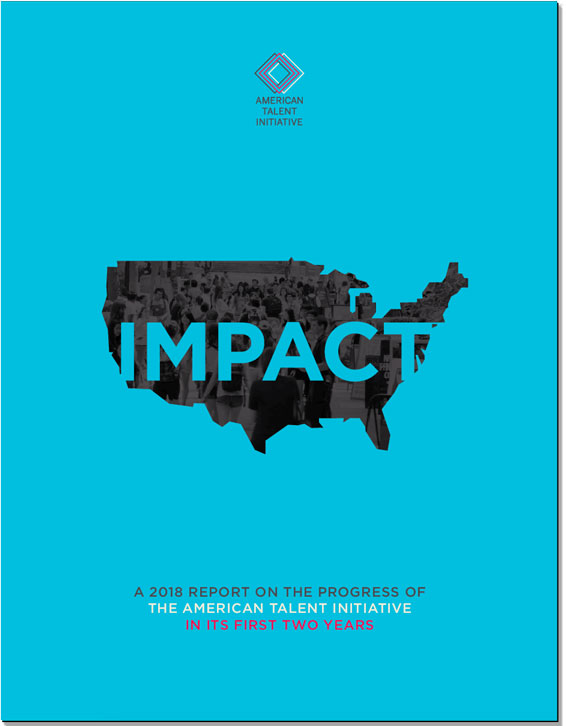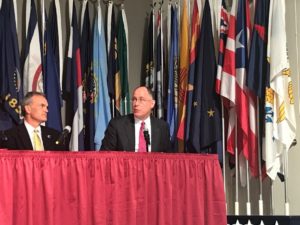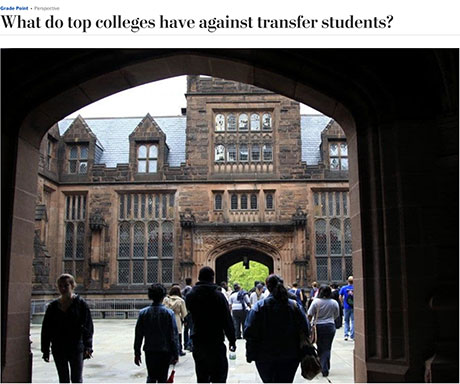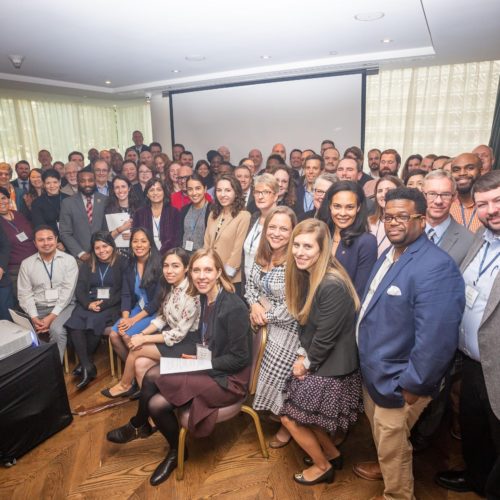
Quarterly Newsletter
Welcome to The American Talent Initiative quarterly newsletter – your source for news and insights on how we’re working toward our 50,000-by-2025 goal.
The American Talent Initiative Impact Report

Today, the American Talent Initiative released its 2018 Impact Report, which details collective progress to the goal of enrolling 50,000 more low- and moderate-income students by 2025.
Two years after ATI’s founding, data show that ATI members have collectively increased enrollment of students who receive Pell grants by 7,291, achieving 15 percent of the initiative’s overall goal.
For many ATI members, this progress reflects a reversal of declining or stagnant enrollment trends for lower-income students in the years before joining ATI.
Read this Wall Street Journal piece for coverage of the report.
Welcoming New Steering Committee Members
We’re excited to welcome Chancellor Carol Folt of the University of North Carolina at Chapel Hill and President Eric F. Spina of the University of Dayton as the two newest members of ATI’s steering committee. ATI steering committee members include:
- Ana Mari Cauce, President, University of Washington
- Michael V. Drake, President, The Ohio State University
- Christopher Eisgruber, President, Princeton University
- Carol Folt, Chancellor, University of North Carolina at Chapel Hill
- Martin Kurzweil, Director, Educational Transformation Program, Ithaka S+R
- Daniel R. Porterfield, President and CEO, The Aspen Institute
- Carol Quillen, President, Davidson College
- Eric F. Spina, President, University of Dayton
- Joshua Wyner, Vice President and Executive Director, College Excellence Program, The Aspen Institute
Please join us in welcoming President Spina and Chancellor Folt! We know that their enthusiasm for and demonstrated commitment to ATI will add tremendous value to our committee, to ATI members, and to our cause.
Presidential Perspective: Chancellor Robert Jones, University of Illinois at Urbana-Champaign
The University of Illinois at Urbana-Champaign has shown a commitment to lower-income students, expanding its number of Pell recipients by more than 1,000 during a time of budgetary crisis in the state. The ATI team connected with Chancellor Robert Jones to discuss the institution's success, goals, and investment in ATI.
 Q: What made you want to be involved in the American Talent Initiative?
Q: What made you want to be involved in the American Talent Initiative?
A: It’s pretty simple. I’m extremely passionate about access to and affordability of higher education, and it didn’t start when I became chancellor or president of a university. It goes all the way back to the good old days when I was running my research lab and the first activity I got pulled into outside of my lab was trying to recruit more under-represented minorities, particularly more African American students, into STEM careers. It is one of those grand challenges that all institutions of higher education need to be more strategic and intentional about when thinking about how we solve this complex issue. When I learned about the players and partners involved in ATI, and given my knowledge of the work Illinois was doing to address these issues, the only answer was yes. We’re enthused to be a part of this.
Q: How do you talk about expanding opportunities for low-income students? How do you work with your leadership team, board, or other stakeholders on issues of access and success?
A: It doesn’t take rocket science to understand that if we are to remain and advance as a competitive nation, we’ve got to think about educating the entire masses of the population. And that we then make sure that educational access and affordability is there for a growing segment of our population that heretofore has been underinvested in—and we haven’t done all that we should to prepare them to be successful in higher education. To me, it comes not only from my sense of University of Illinois moving in an important, strategic direction, but to me this is at the core of what excellence and access to success means for a university. It’s an opportunity to make a very profound statement as chancellor of what is, I think, one of the greatest institutions not only in the country but in the world. Our values–equity, diversity, and inclusivity–are at the core of the value proposition for the University of Illinois. So, for those reasons, it was easy for me to articulate my sense of value around this issue of educational access and affordability.
I also had members of my leadership team around me to send a strong message that this will remain a top priority. We will not cut back because of financial constraints. We’re investing in the future of the university’s reputation as a land grant university and the future success of Illinois and, therefore, the future success of the nation. Our trustees also played an important role as well. While the Illinois commitment didn’t require board approval, I made very, very clear that I had each of their verbal support for this before we rolled it out. I needed to make sure it aligned with their value proposition and the fiduciary governing responsibilities they have for the university. Every last one of them was very excited and very complimentary that we would make this kind of financial commitment and that we were rolling it out in an unusual fashion—with billboards up across the state advertising “Free Tuition- Illinois Commitment.” We noted it as one of the things that our board understands—the proposition that this is an amazing university, and that perhaps we’d been a bit too “Midwest modest” and instead to be bold and forthright about what we value and what we invest in. We make sure our trustees are deeply engaged in the big transformative ideas, so they can be supportive when constituents call and ask questions. And so, in many ways, they are our greatest governing entity but also the greatest advocate for advancing the strategic vision of the university.
Q: You expanded the number of Pell recipients enrolled by more than 1,000 during a time of budgetary crisis. What were some of the hard choices you had to make to continue to keep focused on that priority?
A: Illinois had already started down this path before I became the chancellor. I was absolutely committed that we would continue this work, and also that we needed to have an even greater sense of urgency moving forward. We have the largest first-year cohort in the history of the university this year—the most diverse class in the history of the university, with the highest number of first-generation college students. It kind of evolved out of the last strategic plan that was a three-year process that my colleague Dr. Wise rolled out as chancellor. We decided across the board that we would build on that plan, rather than what happens far too often, which is a new leader comes in and decides to reset everything around their vision of the world and where the institution needs to go. The issues that ATI has been formed to address are at the core of that strategic vision, not at the margins.
During the budget crisis, we were able to do an external analysis of our equity and diversity work and create, for the first time, a senior chief diversity officer position. When the state didn’t pay our monetary award program for a couple of years, we had one option: You could pass it along to the students, students that could really ill-afford another item on their bill statement, but we decided very early to protect the students and our faculty as much as we could from the budget crisis. So not only did we cover the cost of the monetary award program, we also increased our investments in financial aid. By the end of my first year, I’d made a commitment to increase by another $10 million. So even in the times of deep budgetary and other challenges, you have to try to protect things that are core to your mission. Access and affordability, and what I call “access to success.” We provide not only access to the university, but access to great careers.
I hope I’m not making it seem like it was simple–it’s not simple–but it comes from a deep sense of commitment that this is at the core of what we care about as an institution, and it should be at the core of those who have been entrusted with future generations of educational attainment and the role that institutions must play in driving the economic vitality and competitiveness of this nation and the decades ahead. While we are very proud of the number of underrepresented groups, first-generation students, low- and middle-income students that we admit, we have to do more. But we know fundamentally that we can’t do this alone.
Q: What opportunities has joining ATI created for you at Illinois?
A: Being a part of ATI has allowed us to take this internal effort that we care greatly about and make it become part of a national strategy. We really do believe that that is the only way you end up having the impact that you are seeking. It has provided a very visible, high-profile platform for us to talk in a clear and unambiguous fashion about how important this is. Everybody sits up and listens when you start talking about being in the company of institutions like the 108 that are a part of this. They are all sending the same message—that this is very important to us all—and Bloomberg’s investment and deciding that this is an important strategy carries a lot of weight in the circles that I run in.
Q: When you think about your fellow presidents who have also joined ATI, what lessons or insights do you have to share from your own experience for how they can transform their culture or establish this set of priorities?
A: You know that old saying, “If you want to know my priorities, then follow the money.” I certainly hope that we’ve set an example that even in the midst of a budgetary crisis that did have a reputational impact on us, we decided to not do what is typical in these moments–retreat from access, diversity, and equity—but to strategically invest in it. I can tell you that was the right thing to do. It sent a very strong message about our priorities, and I certainly hope that others can learn from that. We didn’t get a full operating budget, and that did cause some challenges. But we made a strategic decision about every dime that we spent during that period—continuing to invest in excellence, continuing to invest in academic access, and then, coming out of that, making a very strong commitment to send a different message about affordability.
That’s why the Illinois Commitment, which covers tuition and fees for up to four years for all qualified in-state students, is so powerful. It sends the very strong message that regardless of your social and economic status, if you work hard and you prepare yourself and get admitted to the university, then you too can have an Illinois education. We found that optics around sticker price was driving behavior that was antithetical to the goals that ATI and others are interested in. Students were saying, “Well, I can’t afford to go to a place like Illinois, so if I go to college, I’m going to go elsewhere.” We wanted to send the message that at the end of the day, if you meet the profile to be accepted, then you don’t have to worry about what it costs. Prepare yourself, and you too can benefit from an Illinois education. I think there are some lessons in there about sticking to your goals, making sure your strategic priorities align with your vision, and making sure that your budgetary allocation process supports those core values in your strategic plan for moving the institution forward.
Q: What do you see as ATI’s potential impact beyond its membership?
A: I think that ATI will be a prime example of the value proposition and the effectiveness of collective impact strategies, because these societal challenges regarding educational equity are too big and too complex for any university to solve alone. It is going to be critically important that we are all rowing in the same direction, that we all have a common set of goals and objectives that we are working toward. It won’t be just hype; it will be, “Look at the numbers.” That speaks volumes. I fundamentally believe that we are going to surpass our goals, at least at my institution. And I have to institutionalize that. When I’m no longer sitting in this chair, it needs to be such a part of the culture of the university that no one thinks about touching it, just like no one would think about reducing the size of our research enterprise or not having undergraduate teaching at the heart of what we do.
ATI Launches the Veterans Community of Practice
 On November 14th, at a conference hosted by the CollegeBoard and Ithaka S+R, leaders from higher education, military, and veterans’ organizations met to commit to improving higher education opportunities for military veterans. During the conference, University of Dayton president Eric F. Spina – a member of ATI’s Steering Committee – shared the exciting news that 34 ATI Institutions have joined together in a community of practice committed to improving student veteran access and success at high-graduation-rate institutions. Many ATI members participating in the community of practice have longstanding commitments to serving veterans and are interested in improving their existing programs and sharing their best practices with peers, while other ATI members are just beginning to think about veterans’ access and success. Through the new community of practice, participating ATI members will set goals related to improving access and success of veterans; share best practices about recruiting and enrolling veterans, and supporting them once they are on campus; develop better, simpler pipelines for veterans transferring from community colleges and with prior credits; report data on veterans’ enrollment and success; and press for changes that will improve veterans’ college choices.
On November 14th, at a conference hosted by the CollegeBoard and Ithaka S+R, leaders from higher education, military, and veterans’ organizations met to commit to improving higher education opportunities for military veterans. During the conference, University of Dayton president Eric F. Spina – a member of ATI’s Steering Committee – shared the exciting news that 34 ATI Institutions have joined together in a community of practice committed to improving student veteran access and success at high-graduation-rate institutions. Many ATI members participating in the community of practice have longstanding commitments to serving veterans and are interested in improving their existing programs and sharing their best practices with peers, while other ATI members are just beginning to think about veterans’ access and success. Through the new community of practice, participating ATI members will set goals related to improving access and success of veterans; share best practices about recruiting and enrolling veterans, and supporting them once they are on campus; develop better, simpler pipelines for veterans transferring from community colleges and with prior credits; report data on veterans’ enrollment and success; and press for changes that will improve veterans’ college choices.
ATI members had a chance to participate in the CollegeBoard-Ithaka conference, gaining insights from panels on the student veteran experience, the institutional perspective on the benefits of veterans, and recruiting, admitting, and supporting student veterans on campus.
ATI will continue to provide updates as this community of practice moves forward. If your institution is interested in joining the Veterans’ Community, please contact Emily Schwartz.
- Allegheny College
- Amherst College
- Bard College
- Bates College
- Bowdoin College
- Carleton College
- Claremont McKenna College
- Columbia University
- Cornell University
- Emory University
- Fordham University
- Georgetown University
- Harvard University
- Indiana University
- Johns Hopkins University
- Juniata College
- Lebanon Valley College
- Lehigh University
- Marist College
- Muhlenberg College
- The Ohio State University
- Penn State University
- Princeton University
- Rutgers University-New Brunswick
- St. Mary's College of Maryland
- Swarthmore College
- University of California, Davis
- University of Maryland, College Park
- University of Michigan-Ann Arbor
- University of North Carolina at Chapel Hill
- University of Dayton
- Vassar College
- Williams College
- Yale University
The American Talent Initiative in the News:
[su_row][su_column size="1/2"]
By Martin Kurzweil and Josh Wyner
The American Enterprise Institute recently released a report that claimed that America’s selective colleges have held steady in their enrollment of low-income students, while seeing a decline in middle-income students. Though it is not stated directly, the authors seem to be saying that colleges should shift their attention from low-income to middle-income students. Also implied is that as long as colleges continue to enroll the same share of low-income students, they’re doing enough. Maintaining the status quo, however, isn’t enough...
Read more from The Washington Post.
[/su_column][su_column size="1/2"]
In May, Princeton University announced that it accepted 13 transfer students for this fall's freshman class. And while that is a tiny fraction of the 1,300 students expected to arrive this fall on campus, the news was still significant: It marked the first time since 1990 that Princeton had accepted transfer students.
The image of the modern undergraduate is no longer one that packs up the family minivan three months after high school graduation to move away to college for four years. More than one-third of college students today transfer at least once before earning a bachelor's degree...
Read more from the Washington Post.
[/su_column][/su_row]
Milestones and Key Dates
ATI Presidential Summit
February 5th, 2019 in New York, N.Y.
If you have not yet registered for the summit and plan to attend, please contact McKenzie Maxson.
ATI 2019 Strategic Support Meeting
Please save the date!
June 17-18, 2019 in Washington, D.C.
Georgetown University Summer Institute on Equity in the Academic Experience
June 24th-26th, 2019 in Washington, D.C.
We are excited to extend an invitation to all ATI member schools for a new Summer Institute on Equity in the Academic Experience, offered as an opportunity for ATI schools to advance their work. The Institute will be held this summer, June 24-26, 2019 at Georgetown University in Washington, D.C. It is hosted by Georgetown and University of Texas at Austin, in collaboration with ATI.
Questions? Please reach out to Mark Joy at mwj8@georgetown.edu with the subject line: Summer Institute.
If you would like to include an announcement or other information in the ATI newsletter, please contact McKenzie Maxson.
The American Talent Initiative
Author
-

The American Talent Initiative (ATI) is a Bloomberg Philanthropies-supported collaboration between the Aspen Institute's College Excellence Program, Ithaka S+R, and a growing alliance of colleges and universities dedicated to substantially expanding opportunity and access for low- and moderate-income students. ATI members—all graduating at least 70 percent of their students within six years—have joined together to address this challenge.
View all posts






